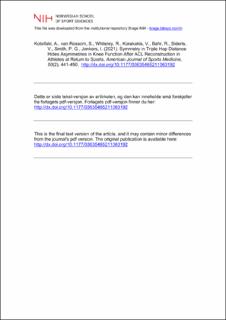| dc.contributor.author | Kotsifaki, Argyro | |
| dc.contributor.author | van Rossom, Sam | |
| dc.contributor.author | Whiteley, Rodney | |
| dc.contributor.author | Korakakis, Vasileios | |
| dc.contributor.author | Bahr, Roald | |
| dc.contributor.author | Sideris, Vasileios | |
| dc.contributor.author | Smith, Philip Graham | |
| dc.contributor.author | Jonkers, Ilse | |
| dc.date.accessioned | 2022-03-11T10:02:33Z | |
| dc.date.available | 2022-03-11T10:02:33Z | |
| dc.date.created | 2022-01-13T19:49:06Z | |
| dc.date.issued | 2021 | |
| dc.identifier.citation | American Journal of Sports Medicine. 2021, 50(2), 441-450. | en_US |
| dc.identifier.issn | 0363-5465 | |
| dc.identifier.uri | https://hdl.handle.net/11250/2984556 | |
| dc.description | I Brage finner du siste tekst-versjon av artikkelen, og den kan inneholde ubetydelige forskjeller fra forlagets pdf-versjon. Forlagets pdf-versjon finner du på journals.sagepub.com / In Brage you'll find the final text version of the article, and it may contain insignificant differences from the journal's pdf version. The definitive version is available at journals.sagepub.com | en_US |
| dc.description.abstract | Background: After anterior cruciate ligament reconstruction (ACLR), a battery of strength and hop tests is frequently used to determine the readiness of an athlete to successfully return to sports. However, the anterior cruciate ligament reinjury rate remains alarmingly high. Purpose: To evaluate the lower limb function of athletes after ACLR at the time when they had been cleared to return to sports (RTS). We aimed to evaluate if passing discharge criteria ensures restoration of normal lower limb biomechanics in terms of kinematics, kinetics, work, and percentage work contribution during a triple hop for distance. Study Design: Controlled laboratory study. Methods: Integrated 3-dimensional motion analysis was performed in 24 male athletes after ACLR when cleared to RTS and 23 healthy male controls during the triple-hop test. The criteria for RTS were (1) clearance by the surgeon and the physical therapist, (2) completion of a sports-specific on-field rehabilitation program, and (3) limb symmetry index >90% after quadriceps strength and hop battery tests. Lower limb and trunk kinematics, as well as knee joint moments and work, were calculated. Between-limb differences (within athletes after ACLR) and between-group differences (between ACLR and control groups) were evaluated using mixed linear models. Results: Although achieving 97% limb symmetry in distance hopped and displaying almost 80% symmetry for knee work absorption in the second rebound and third landing, the ACLR cohorts demonstrated only 51% and 66% limb symmetry for knee work generation in the first and second rebound phases, respectively. During both work generation phases of the triple hop, the relative contribution of the involved knee was significantly smaller, with a prominent compensation from the hip joint (P < .001, for all phases) as compared with the uninvolved limb and the controls. In addition, patients deployed a whole body compensatory strategy to account for the between-limb differences in knee function, mainly at the hip, pelvis, and trunk. Conclusion: Symmetry in the triple hop for distance masked important deficits in the knee joint work. These differences were more prominent during work generation (concentric-propulsive) than work absorption (eccentric-landing). | en_US |
| dc.language.iso | eng | en_US |
| dc.subject | anterior cruciate ligament reconstruction | en_US |
| dc.subject | eturn to sport | en_US |
| dc.subject | injury prevention | en_US |
| dc.subject | biomechanics | en_US |
| dc.subject | hop test | en_US |
| dc.title | Symmetry in Triple Hop Distance Hides Asymmetries in Knee Function After ACL Reconstruction in Athletes at Return to Sports | en_US |
| dc.type | Peer reviewed | en_US |
| dc.type | Journal article | en_US |
| dc.description.version | acceptedVersion | en_US |
| dc.source.pagenumber | 10 | en_US |
| dc.source.journal | American Journal of Sports Medicine | en_US |
| dc.identifier.doi | 10.1177/03635465211063192 | |
| dc.identifier.cristin | 1980803 | |
| dc.description.localcode | Institutt for idrettsmedisinske fag / Department of Sports Medicine | en_US |
| cristin.ispublished | true | |
| cristin.fulltext | postprint | |
| cristin.qualitycode | 2 | |
